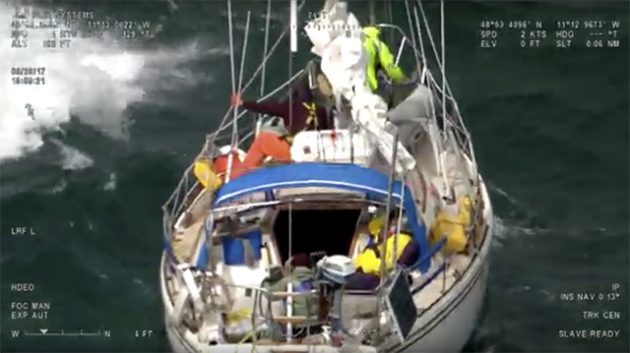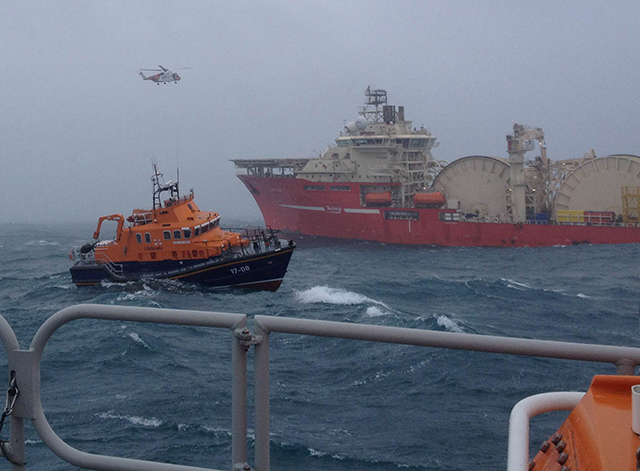A UK Coastguard search and rescue helicopter made a 530-mile round trip yesterday to rescue a desperately unwell yachtsman 203nm west south west from the Isles of the Scilly, in rough seas in the Atlantic Ocean.
The yacht crew used their satellite phone to declare their Mayday to the Coastguard at 11.40am on 29 June, reporting that one of their crew was unwell and needed urgent medical assistance.
Due to the distance involved, communication with the vessel was poor and patchy, so the UK Coastguard got the yacht to activate their EPIRB to establish their exact position. A Mayday relay broadcast was then issued asking all nearby vessels for assistance.
A military fixed wing aircraft and an Irish Casa fixed wing aircraft took turns to establish communications with the vessel so that information could be relayed back to the UK Aeronautical Rescue Co-ordination Centre (ARCC) which is based at the National Maritime Operations Centre in Fareham.
The Coastguard were able to keep in constant contact with the vessel and relay information to the Coastguard helicopter who made its way to the stricken casualty from its base at Newquay.
The Coastguard helicopter refuelled in the Isles of Scilly and arrived on scene just before 4pm and winched the casualty on board. On its return journey it refuelled again on the Scillies and the casualty was landed at Newquay Airport for further transfer to Treliske Hospital by land ambulance.
Mark Rodaway, Commander for the UK Coastguard said: ‘At this range, it was vital that the helicopter was able to rendezvous with the vessel and evacuate the unwell crewman with as little delay as possible. This is a superb example of military and Irish Coast Guard co-operation and we would like to thank all those who have played their part in bringing this rescue to a textbook conclusion.
‘Our priority is to protect life at sea and we will always do everything possible to provide assistance for a mariner in need. Thankfully, we have been able to get him to hospital and we hope he is on the road to recovery after his ordeal.’
Yachtsman rescued off Scotland’s coast arrested on international warrant
A sailor who was airlifted to safety after his yacht ran aground off the west coast of Scotland has been…
Stunning footage of yachtswoman airlift during Clipper Race
UK Coastguard have released dramatic video footage of the rescue from the Clipper Race yacht, to medevac a crew member…
UK Coastguard helicopter’s 180-mile mission to save injured seafarer
The UK Coastguard has released details about a 'life or death' search and rescue helicopter mission to rescue an unwell…
Man airlifted in gale force weather after boat runs aground
A boatsman who ran aground in gale-force weather was airlifted to safety by the UK Coastguard search and rescue helicopter…
Mark Coupland, chief pilot for the UK Coastguard search and rescue helicopter based at Newquay Airport said: ‘Our Coastguard helicopters have a range of just over 200 nautical miles dependant on the wind. Due to the long range involved, we were supported by military and Irish Casa fixed wing aircraft to help us complete the mission successfully.
‘They provided vital communications assistance between the vessel and our aircraft as well as maintaining a watchful eye over us at such a great distance from land. Just as importantly they made sure the vessel had adjusted its course to prepare for the winching which saved us valuable time on scene.
‘Their support ensured our hover time was dramatically reduced which meant we were able to winch the crewman on board in a matter of minutes. In the heavy sea state the vessel was obviously having difficulty maintaining a steady course which we required to conduct a transfer from the deck.
‘Due to the limited time available to us we suggested they stream their dinghy with the casualty in it to allow a swift pick up while maintaining clearance from the yacht’s mast. When you’re operating at the limits of your range and endurance in a potentially life and death situation such as this one, every minute counts.
‘We wish the crewman a speedy recovery.’








